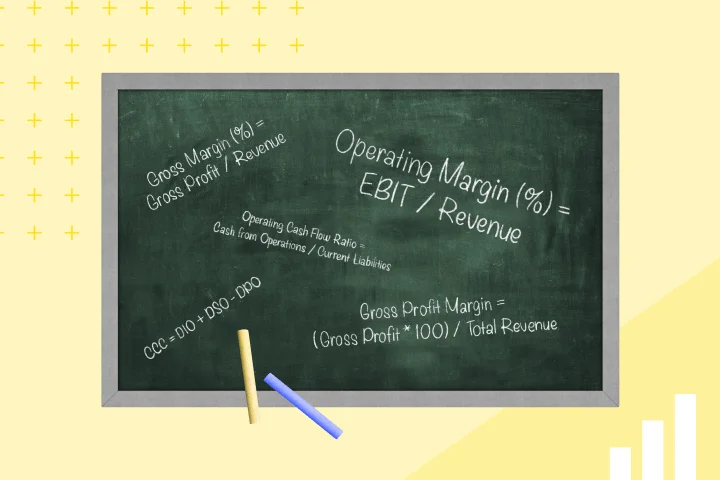Whether you’re a five-person startup or multi-billion-dollar enterprise, your finance function is the beating heart of your organization: it helps you invest profitably, determines where to channel your company’s efforts, how much money you can take off the table as profits, and helps you uncover any unforeseen challenges to your company’s health.
That’s where the position of the CFO comes in: as chief financial officer in 2024, it’s your responsibility to keep your hand on your company’s financial pulse, using a handful of metrics to measure relative health, advise of planned investments or initiatives, and identify challenges that might hinder your company’s profitability and growth.
Here is a quick recap of some of the most important metrics to track and the formulas to figure them out.
For more insight into these metrics, download our Metrics every CFO needs to know (and track) in 2024 guide.
Revenue Growth Rate
Revenue Growth Rate = (Final Value – Initial Value) / Initial Value
Total Revenue
Total Revenue = Number of Units Sold * Consumer’s Cost of Product/Service
Net Revenue
Net Revenue = Gross Revenue – Returns – Discounts – Sales Allowance
Revenue Per Customer
Revenue per customer = Total Revenue / Customer Count
Net Profit Margin
Net Profit Margin = (Revenue – Cost of goods sold – Operating expenses – Interest – Taxes) * 100 / Revenue
Gross Profit Margin
Gross Profit Margin = (Gross Profit * 100) / Total Revenue
Gross Margin (%)
Gross Margin (%) = Gross Profit / Revenue
Operating Profit Margin
Operating Profit Margin = (Revenue + Interest + Taxes) * 100 / Net Sales
Operating Margin (%)
Operating Margin (%) = EBIT / Revenue
Net Profit Margin
Net Profit Margin (%) = Net Income / Revenue
Contribution Margin
Contribution Margin = Price per Unit – Variable Cost per Unit
Customer Acquisition Cost (CAC)
Customer Acquisition Cost (CAC) = (Cost of Sales + Cost of Marketing) / New Customers Acquired
Customer Lifetime Value (CLV)
Customer Lifetime Value (CLV) = Customer Value (CV) * Average Customer Lifespan (ACL)
Churn Rate
Churn Rate = (Lost Customers / Total Customers at the Start of Time Period) * 100
Average Revenue Per User (ARPU)
Average Revenue per User (ARPU) = Total Revenue / Total Number of Users
Average Revenue per User (ARPU) = Total Revenue During Set Time Period / Number of Active Users During Set Time Period
Return on Sales
Return on Sales = Operating Profit * 100 / Net Sales Revenue
Break-even Point (BEP)
Break-Even Point (BEP) = Fixed Costs / Contribution Margin
Price-Earnings Ratio
P/E Ratio = Market Share Price / Earnings per Share (EPS)
Earnings Per Share (EPS)
Earnings per Share (EPS) = (Net Income – Preferred Dividends) / Weighted Average Number of Shares Outstanding
Market Capitalization
Market Capitalization = Latest Closing Share Price * Total Diluted Shares Outstanding
Debt to Equity Ratio
Debt to Equity Ratio = Total Liabilities / Shareholders’ Equity
Cash Conversion Cycle (CCC)
Cash Conversion Cycle (CCC) = DIO + DSO – DPO
Days Inventory Outstanding (DIO) = (Inventory / Cost of Goods Sold) * 365
Days Sales Outstanding (DSO) = (Accounts Receivable / Net Credit Sales) * 365
Days Payable Outstanding (DPO) = (End of Period) Accounts Payable / (Cost of Goods Sold / 365)
Operating Cashflow Margin
Operating Cash Flow Margin = Operating Cash Flow / Operating Revenue * 100%
Operating Cashflow Ratio
Operating Cashflow Ratio = Cash From Operations / Current Liabilities
Cashflow Return on Investment (CFROI)
Cash Flow Return on Investment (CFROI) = Operating Cash Flow / (Total Assets – Total Current Liabilities)
Now that you’ve got the formulas, see how to use these metrics to make effective business decisions by downloading our Metrics every CFO needs to know (and track) in 2024 guide.
-
Get the latest blogs from Mesh by subscribing to our newsletter







